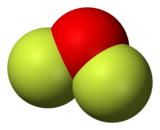Oxygen difluoride
 |
|
 |
|
| Names | |
|---|---|
| Other names
oxygen fluoride
hypofluorous anhydride |
|
| Identifiers | |
|
3D model (Jmol)
|
|
| ChEBI | |
| ChemSpider | |
| ECHA InfoCard | 100.029.087 |
| EC Number | 231-996-7 |
|
PubChem CID
|
|
| RTECS number | RS2100000 |
|
|
|
|
| Properties | |
| OF2 | |
| Molar mass | 53.9962 g/mol |
| Appearance | colorless gas, pale yellow liquid when condensed |
| Odor | peculiar, foul |
| Density | 1.90 g/cm3 (-224° C, liquid), 1.719 g/cm3 (-183° C, liquid), 1.521 g/cm3 (liquid at −145 °C), 1.88 g/l (gas at room temperature) |
| Melting point | −223.8 °C (−370.8 °F; 49.3 K) |
| Boiling point | −144.75 °C (−228.55 °F; 128.40 K) |
| hydrolyzes | |
| Vapor pressure | >1 atm (20°C) |
| Thermochemistry | |
| 43.3 J/mol K | |
|
Std molar
entropy (S |
246.98 J/mol K |
|
Std enthalpy of
formation (ΔfH |
24.5 kJ mol−1 |
|
Gibbs free energy (ΔfG˚)
|
42.5 kJ/mol |
| Hazards | |
| Lethal dose or concentration (LD, LC): | |
|
LC50 (median concentration)
|
2.6 ppm (rat, 1 hr) 1.5 ppm (mouse, 1 hr) 26 ppm (dog, 1 hr) 16 ppm (monkey, 1 hr) |
| US health exposure limits (NIOSH): | |
|
PEL (Permissible)
|
TWA 0.05 ppm (0.1 mg/m3) |
|
REL (Recommended)
|
C 0.05 ppm (0.1 mg/m3) |
|
IDLH (Immediate danger)
|
0.5 ppm |
| Related compounds | |
|
Related compounds
|
HFO O2F2 NHF2 NF3 SCl2 |
|
Except where otherwise noted, data are given for materials in their standard state (at 25 °C [77 °F], 100 kPa).
|
|
|
|
|
| Infobox references | |
Oxygen difluoride is the chemical compound with the formula OF2. As predicted by VSEPR theory, the molecule adopts a "bent" molecular geometry similar to that of water, but it has very different properties, being a strong oxidizer.
Oxygen difluoride was first reported in 1929; it was obtained by the electrolysis of molten potassium fluoride and hydrofluoric acid containing small quantities of water. The modern preparation entails the reaction of fluorine with a dilute aqueous solution of sodium hydroxide, with sodium fluoride as a side-product:
Its powerful oxidizing properties are suggested by the oxidation number of +2 for the oxygen atom instead of its normal -2. Above 200 °C, OF2 decomposes to oxygen and fluorine via a radical mechanism.
OF2 reacts with many metals to yield oxides and fluorides. Nonmetals also react: phosphorus reacts with OF2 to form PF5 and POF3; sulfur gives SO2 and SF4; and unusually for a noble gas, xenon reacts, at elevated temperatures, yielding XeF4 and xenon oxyfluorides.
...
Wikipedia
